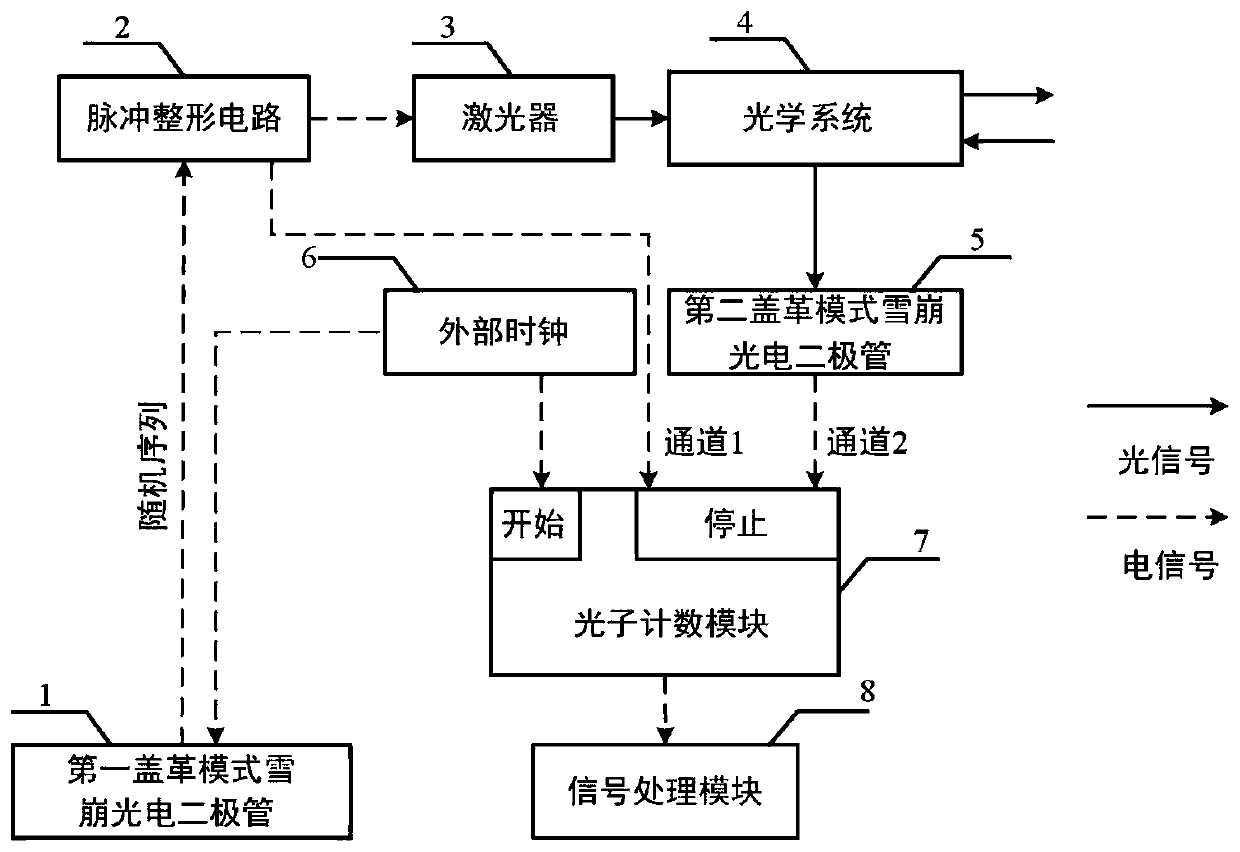Photon counting laser radar based on true random coding
A technology of photon counting and laser radar, which is applied to the re-radiation of electromagnetic waves, instruments, and measuring devices, can solve problems such as low practicability, difficult engineering application, and poor ranging performance, so as to improve correlation and reduce measurement time , Improve the effect of ranging ability
- Summary
- Abstract
- Description
- Claims
- Application Information
AI Technical Summary
Problems solved by technology
Method used
Image
Examples
specific Embodiment approach 1
[0019] Specific implementation mode one: see figure 1 Describe this embodiment mode, a photon counting laser radar with true random coding described in this embodiment mode, it includes a first Geiger mode avalanche photodiode 1, a pulse shaping circuit 2, a laser 3, an optical system 4, a second Geiger mode mode avalanche photodiode 5, external clock 6, photon counting module 7 and signal processing module 8; the first Geiger mode avalanche photodiode 1 responds to thermal noise or background light noise, and its output terminal is connected to the pulse shaping circuit The input terminals are connected, and the pulse shaping circuit 2 shapes the electrical pulses to obtain a random sequence of narrow pulses. One of its output terminals is connected to the first channel of the photon counting module 7 to obtain the reference template a(n) of the random sequence, and the other The output end is connected to the input end of the laser 3, the laser 3 receives the electrical puls...
specific Embodiment approach 2
[0020] Embodiment 2: The difference between this embodiment and the photon counting lidar with random codes described in Embodiment 1 is that the specific process of generating the real machine code sequence is as follows:
[0021] When the first Geiger mode avalanche photodiode 1 is energized, due to the thermal noise of the detector itself, there will be pulses even in the case of a dark room, which is called dark count, and the number of dark counts is the same as that of the first Geiger mode avalanche The operating temperature of the photodiode is dependent. At the same time, the first Geiger mode avalanche photodiode 1 also responds to the incident background light. Through the response to dark noise and background light noise, the final periodic output pulse random sequence. The periodic output of the pulse sequence is mainly realized by adding a gating circuit to the first Geiger mode avalanche photodiode 1. The high level of the first Geiger mode avalanche photodiode...
specific Embodiment approach 3
[0022] Specific embodiment three: the difference between this embodiment and the photon counting laser radar with true random coding described in specific embodiment two is that the photon counting laser radar system with true random coding described in specific embodiment three realizes specific ranging The process is:
[0023] The laser 3 receives the electric pulse sequence generated in the second embodiment, modulates the continuous laser light into a random light pulse sequence according to the input random electric pulse sequence, and the output light pulse sequence irradiates the target through the optical system 4, and is scattered by the target Part of the laser echo signal will return to the optical system 4, and then transmitted to the second Geiger mode avalanche photodiode 5 through the optical system 4, and the second Geiger mode avalanche photodiode 5 responds to the laser echo signal by outputting an electric pulse, and The electrical pulse signal of the second...
PUM
 Login to View More
Login to View More Abstract
Description
Claims
Application Information
 Login to View More
Login to View More - R&D
- Intellectual Property
- Life Sciences
- Materials
- Tech Scout
- Unparalleled Data Quality
- Higher Quality Content
- 60% Fewer Hallucinations
Browse by: Latest US Patents, China's latest patents, Technical Efficacy Thesaurus, Application Domain, Technology Topic, Popular Technical Reports.
© 2025 PatSnap. All rights reserved.Legal|Privacy policy|Modern Slavery Act Transparency Statement|Sitemap|About US| Contact US: help@patsnap.com



